RBA interest rates live updates: All the latest news from the Reserve Bank’s December board meeting

If you’ve tuned in hoping against hope for a Christmas miracle on interest rates, look away now. We’re afraid those grinches at the Reserve Bank have none to give.
The sack is empty, the candy canes and cookies are all gone and no-one even bothered to untangle the lights this year. (But, just to rub a little extra Christmas ham salt into those gaping financial wounds, that bloody Mariah Carey song is still on the radio).
In fairness, we shouldn’t have dared to dream. The writing has been on the wall for some time ... for most of the year in fact. For anyone with a mortgage, it’s nothing but big lumps of something a whole lot dirtier than coal this Christmas.
At least the bad news will be served with a smile from head elf Michele Bullock when she steps out to address the media later today.
Turning our Economics 101 textbooks to Chapter 3, we can see that in times of financial strife, an economy’s jobless rate goes up which helps to keep a lid on overall spending. That then eventually forces the central bank to loosen its grip on credit and things slowly get a little better.
That’s the theory anyway. But there’s not much evidence of that here right now. More than a year of the official cash rate treading water at 4.35 per cent has barely made a dent in Australia’s stubbornly low level of unemployment.
That resilience — coupled with an inflation rate that is now within the RBA’s preferred sweet spot of between 2 and 3 per cent, but not yet sustainably so — means the chance of a move on rates today is about as likely as Santa putting Donald Trump on the nice list this year.
The board also continues to say it can’t rule out a rate rise ... but again, no one genuinely believes that’s a possibility right now.
So, with no Christmas joy in sight, what’s next?
Our brightest financial minds have pushed expectations of a rate cut out to the middle of next year, certainly not the February target many had forecast earlier this year.
The best we can hope for is that the numbers keep going our way.
Just like every family who’ll endure that one creepy uncle who’s life peaked in the 70s and he still thinks there’s nothing wrong with a little casual sexism scattered among the cold meat, prawns and pavlova this Christmas lunch, we could all just use a f..king break.
Key Events
Four in 10 not ready for rates to stay high in 2025
We were promised rate relief by the end of 2024. Then early 2025. Maybe mid-2025?
The warnings have been there but it seems about 40 per cent of borrowers have failed to plan for what comes next if rates stay high through the next year.
A new survey of more than 2000 people by Canstar reveals, of those with an owner-occupier mortgage, only 60 per cent feel financially prepared for interest rates to remain elevated into 2025, while 28 per cent say they are not prepared and 12 per cent are unsure.

One-third of borrowers who are prepared for rates to remain higher for longer say they’ll still be able to meet the repayments if rates climb even higher.
Of the four in 10 owner-occupiers who aren’t sure or don’t have funds to keep paying the mortgage at higher interest rates said they would consider the following options:
- 72 per cent could cut back on living costs further
- 16 per cent may need to sell their property
- 15 per cent might draw from other investments
- 11 per cent would consider seeking help from family or friends
- 8 per cent might apply for hardship assistance from their lender; and
- 2 per cent have alternative options.
Three of the big four bank economic teams – Westpac, NAB and ANZ – now expect the first cash rate cut will come in May 2025, following the March quarterly inflation data, due out in late April.
“This year has been incredibly tough for households with a mortgage, particularly those that had very little in the tank to start with,” says Canstar data insights director Sally Tindall.
“While there has been a small amount of relief from the stage three tax cuts and government electricity rebates, for many families that extra cash has barely touched the sides.”
Young families bear brunt of rising costs
Expenses for families with a child aged younger than five are 27 per cent higher than in 2021, according to research that shows they are suffering most from the cost-of-living crisis.
While headline inflation has fallen to 2.8 per cent, daily out-of-pocket childcare costs are still about $50 per child, analysis by Impact Economics and Policy shows.
This is further proof of the need for serious reform, including the $10-a-day out-of-pocket childcare fee cap the government is reportedly considering as an election promise, Minderoo Foundation’s Thrive by Five campaign says.
While headline inflation has fallen to 2.8 per cent, daily out-of-pocket childcare costs are still about $50 per child, analysis by Impact Economics and Policy shows.
This is further proof of the need for serious reform, including the $10-a-day out-of-pocket childcare fee cap the government is reportedly considering as an election promise, Minderoo Foundation’s Thrive by Five campaign says.
What’s taking so long to deliver a little relief?
It’s the question plenty are asking, particularly as they watch other central banks around the world loosen the purse strings.
The RBA maintains Australia did not take rates as high as its peers and the jobs market has proven unusually strong.
Most market watchers don’t the first cut to come until the June quarter, a departure from the November survey when the first three months of 2025 was the more popular pick.
Economists highlight strength in the labour market and the RBA’s assertive posture on underlying price pressures as reasons to believe the wait for cuts will be a bit longer.
While the annual headline inflation rate is sitting at 2.8 per cent (back within the target band) the RBA’s focus has been on underlying price measures, which have been slower to moderate.
Australian Council of Trade Unions secretary Sally McManus isn;t waiting for the stars to align on the date.
She’s called for interest rates to be lowered now.
“Working people are under so much pressure that household spending actually went backwards last quarter,” Ms McManus said.
“Normally when that happens, the alarm bells sound in the central bank and it urgently cuts interest rates.”
Seriously, how is anyone affording Christmas this year?
You simply can’t put a price on a smile at Christmas … or can you?
But where on earth is this money coming from when, on average, Australian households are only saving 60¢ for every $100 they earn?
For the whole year, that works out to be an average of $720 for each household to cover Christmas, holidays, paying down debts and building up savings.
That means the $1090 household average is an impossibility without going into debt.
But plenty will.
What are the odds?
You’ve got to love an optimist!
Against all odds, they’re the outlier, the lone wolf, the last one standing who still believes.
Only 9 per cent of traders think a cut to 4.1 per cent will be made today.
Others say there are seemingly too few workers to fill jobs in the wider economy for the Reserve Bank to pull the trigger on a cut just yet.
Australian businesses can’t make or sell enough products or provide enough services to grow and increase wages.
IG’s market analyst Tony Sycamore said in welcome news for mortgage holders, Australia’s weak GDP figures last week will likely take on a more dovish tone.
“This change is expected to be evident in the Q&A session, where RBA governor Bullock may drop prior assurances against near-term rate cuts,” he said.
“Instead, she might suggest that the February cash rate decision will hinge on forthcoming inflation data and revised staff forecasts, paving the way for a potential rate cut in February.”
The interest rate market currently assigns a 43 per cent probability to a 25-basis point rate cut by the RBA in February and a 100 per cent probability to a 25-basis point rate cut from the RBA in April.
Complacency costing borrowers a staggering sum each year
The RBA may not have budged on interest rates this year (they’ve been stuck at 4.35 per cent since November 2023), but RateCity says those with a mortgage are still thousands of dollars worse off.
The site’s number crunchers say the average borrower who continued to repay their loan without refinancing to a better rate would be $6000 worse off in the 12 months until November this year..
According to RateCity, the average borrower with a $500,000 loan a year ago will have paid about $35,308 interest on their home loan in the past 12 months.
However, if they had refinanced when the RBA last changed rates, their interest bill would have only been $29,708.
RateCity money editor Laine Gordon said with rates likely to remain on hold for the next five months, borrowers should seek out rate relief over the holiday period.
Around 40 lenders are offering variable home loan rates under 6 per cent.
“Even if you didn’t get around to switching last year, all is not lost. Refinancing now could still save you almost $10,000 in interest over the next two years if you switch to a rate under 6 per cent.”
Last call for 2024
Today’s interest rates decision will be the last until mid February as the RBA board swans off on a summer break.
It means if there’s no shift (as expected), homeowners will have to endure another 10 weeks of belt-tightening.
Under the new central bank meeting regime instituted this year, the board no long meets on the first Tuesday of every month.
They’ll be just eight meetings in 2025.
Mark May 19-20 and July 7-8 for a possible rate relief.
Originally published on The West Australian
